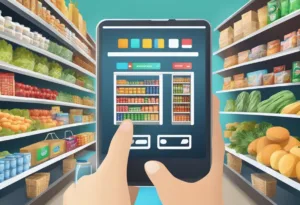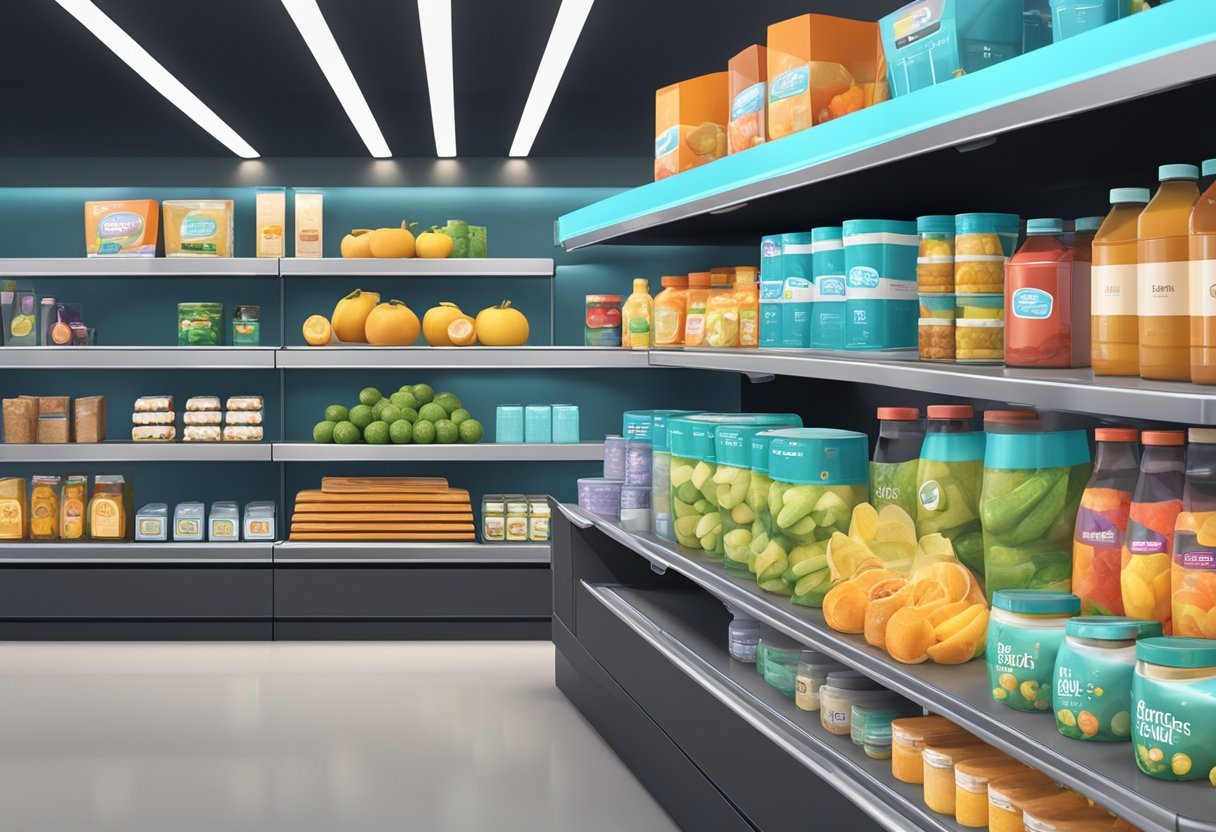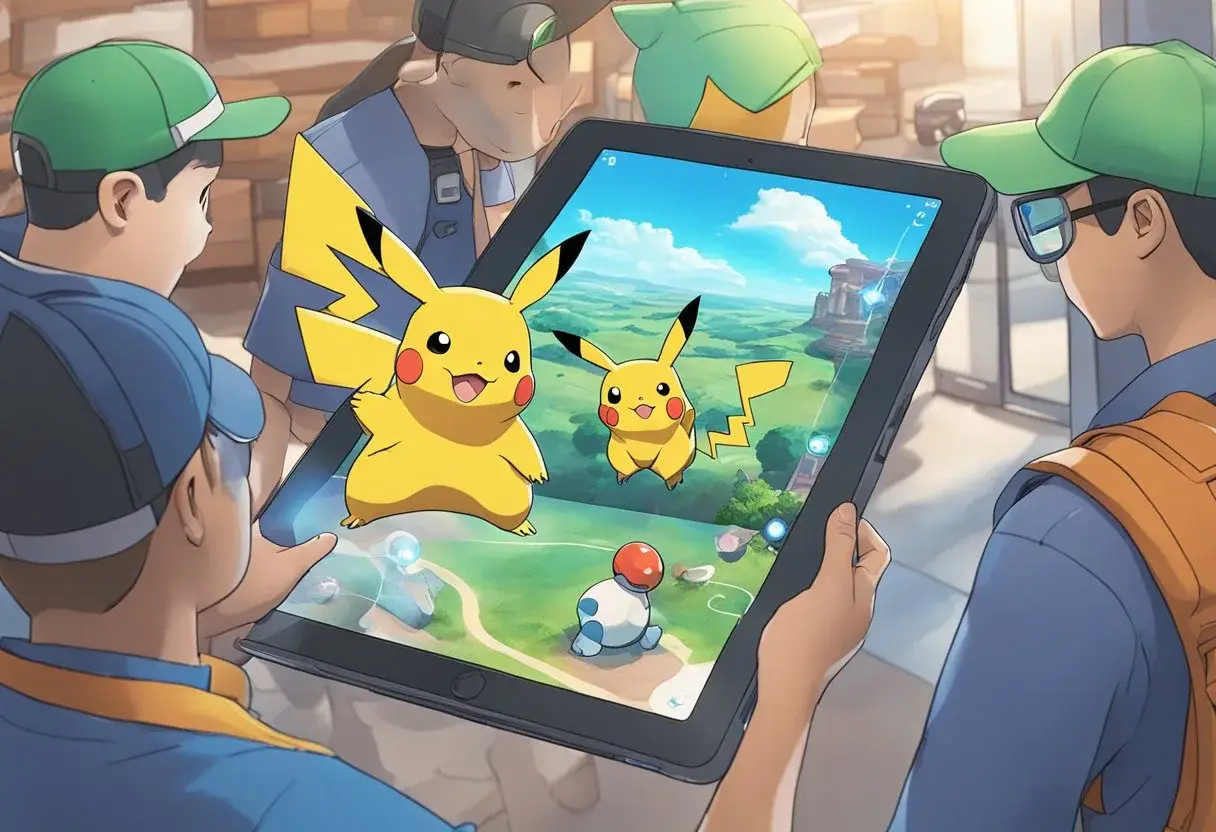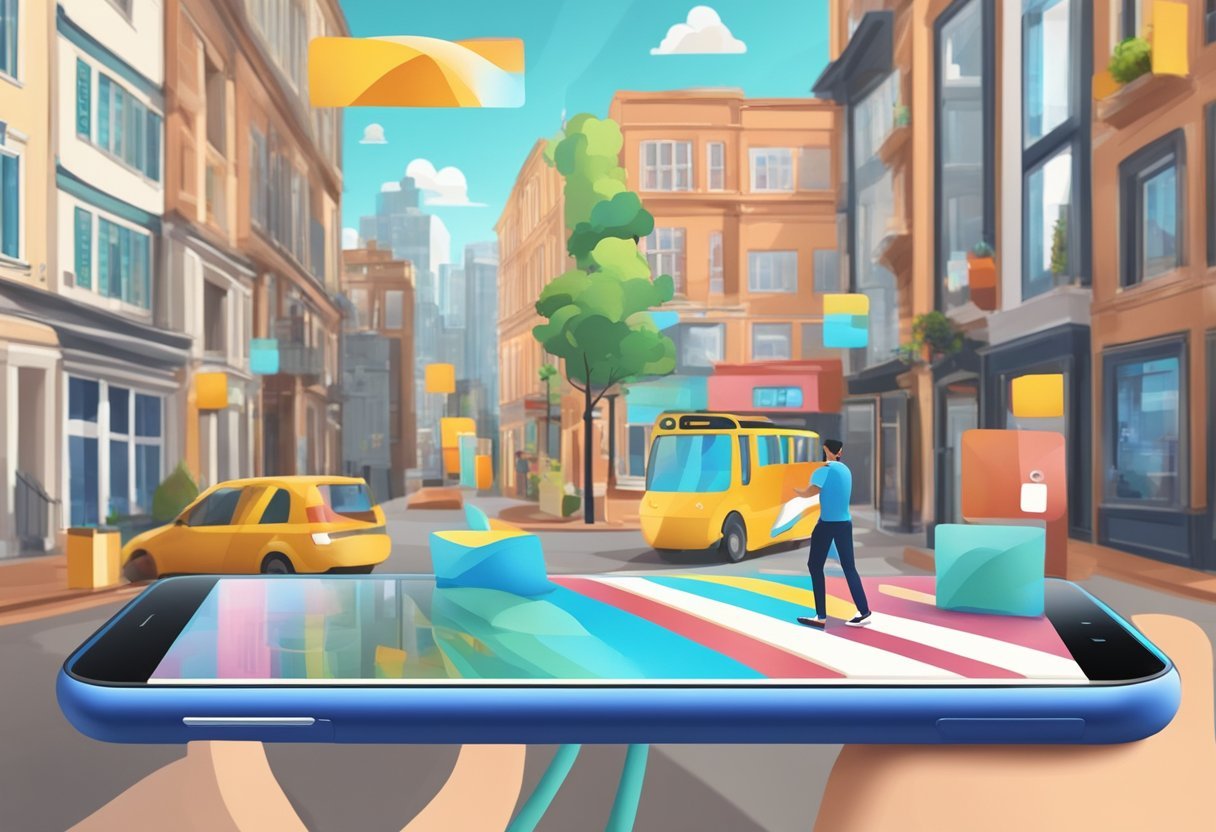Augmented reality (AR) technology has revolutionized the grocery retail industry by providing customers with an immersive shopping experience. AR technology is an interactive and digital platform that superimposes virtual information onto the real world. Grocery stores are leveraging AR technology to enhance customer experience, increase sales, and drive up interest with AR-enhanced marketing campaigns. In this blog post, we will explore the concept of augmented reality grocery store and the 15 brands working on AR platforms
AR technology enables customers to visualize products in 3D, making it easier for them to make informed decisions. Customers can use AR technology to scan items in the store and receive detailed information about the product, such as the ingredients, nutritional information, and price. AR technology also enables customers to try on virtual clothes, accessories, and makeup.
Grocery stores are using AR technology to increase customer engagement and loyalty. By integrating AR technology with social media platforms, grocery stores can create interactive and personalized marketing campaigns that target specific customer segments. AR technology also enables grocery stores to track customer behavior and preferences, which can be used to improve product offerings and customer service.
The Evolution of AR in Grocery Retail
The grocery retail industry has been evolving rapidly with the advent of new technologies, and augmented reality (AR) has been one of the most significant innovations in recent years. AR technology has the potential to enhance the shopping experience for customers by providing them with a more immersive and interactive experience.
From E-commerce to Augmented Shopping
The use of AR in grocery retail has been gaining traction in recent years, with retailers looking to enhance the shopping experience for their customers. AR technology has been used to create virtual stores that allow customers to shop from the comfort of their homes. Customers can use their smartphones or tablets to browse through virtual aisles and select products they want to purchase.
AR technology has also been used to enhance the in-store shopping experience. For instance, retailers can use AR to provide customers with additional information about products, such as nutritional information and recipe ideas. AR can also be used to create interactive displays that engage customers and encourage them to make purchases.
Innovations During Covid-19
The Covid-19 pandemic has accelerated the adoption of AR technology in grocery retail. With social distancing measures in place, retailers have had to find new ways to engage with customers and provide them with a safe shopping experience. AR technology has been used to create contactless shopping experiences that allow customers to scan products and make purchases without having to touch anything.
AR technology has also been used to create virtual queues that allow customers to wait in line without having to physically stand in a queue. This has helped to reduce the risk of transmission of the virus and has made the shopping experience more convenient for customers.
AR technology has the potential to transform the grocery retail industry by providing customers with a more immersive and interactive shopping experience. The technology has already been used to create virtual stores, enhance the in-store shopping experience, and provide contactless shopping experiences during the Covid-19 pandemic. As the technology continues to evolve, we can expect to see more innovative uses of AR in grocery retail in the future.
Use Cases for Augmented Reality Grocery Store

- Interactive Product Information
- Nutritional Information and Dietary Guidance
- In-Store Navigation and Wayfinding
- Virtual Coupons and Promotions
- Augmented Reality Shopping Lists
- Product Comparison and Reviews
- Allergen and Ingredient Alerts
- AR-Enabled Smart Shopping Carts
- Immersive Brand Experiences
- Augmented Reality Cooking Assistance
Interactive Product Information
Augmented reality grocery shopping is transforming the way consumers access product information. By using AR technology, customers can point their smartphone cameras at products to reveal a wealth of information, such as the origin of ingredients, production processes, and even the brand’s ethical practices. This interactive layer of information can significantly enhance the shopping experience by providing transparency and fostering trust between the consumer and the product.
Nutritional Information and Dietary Guidance
Augmented reality grocery shopping is providing a new level of nutritional information and dietary guidance directly on the shop floor. Shoppers can scan products to instantly view nutritional content, serving sizes, and diet-specific information, such as keto-friendly or vegan options. This instant access to detailed information can help customers make healthier choices and adhere to their dietary goals while shopping.
In-Store Navigation and Wayfinding
In-store navigation and wayfinding are being revolutionized by augmented reality grocery shopping. AR apps can offer real-time directions to items on a shopper’s list, highlight on-sale products as customers pass by, or even suggest the most efficient route through the store. This technology can save time, improve the shopping experience, and reduce the frustration of searching for products in large supermarkets.
Virtual Coupons and Promotions
Augmented reality grocery shopping is making coupons and promotions more interactive and accessible. Customers can use AR to discover virtual coupons while browsing the aisles, or they might receive personalized promotions based on their shopping habits. This not only incentivizes purchases but also adds an element of surprise and delight to the grocery shopping experience.
Augmented Reality Shopping Lists
Augmented reality shopping lists are changing the way consumers approach their grocery shopping. Instead of relying on paper lists or mobile apps, AR allows customers to see their shopping list items superimposed in the store environment as they shop. This can help ensure no item is forgotten and can even guide shoppers to the exact location of each product, making shopping more efficient.
Product Comparison and Reviews
Product comparison and reviews are becoming more dynamic with augmented reality grocery shopping. Shoppers can scan multiple products to see side-by-side comparisons of prices, nutritional values, and customer reviews. This level of instant comparison shopping can help customers make more informed decisions and feel more confident in their purchases.
Allergen and Ingredient Alerts
Augmented reality grocery shopping is enhancing the safety and convenience for customers with dietary restrictions. By using AR, shoppers can receive alerts for products containing specific allergens or unwanted ingredients. This proactive feature can prevent adverse reactions and make grocery shopping a less stressful experience for those with food sensitivities.
AR-Enabled Smart Shopping Carts
AR-enabled smart shopping carts are a cutting-edge development in augmented reality grocery shopping. These smart carts can interact with a shopper’s mobile device to provide navigation assistance, product information, and even checkout capabilities as they shop. This integration of AR can streamline the shopping process and offer a futuristic, efficient shopping experience.
Immersive Brand Experiences
Augmented reality grocery shopping is allowing brands to create immersive experiences within the grocery store. Customers can engage with AR content that tells the story behind a product, offers virtual taste tests, or shares recipes and usage ideas. These experiences can strengthen brand loyalty and influence purchasing decisions by creating a memorable connection between the customer and the product.
Augmented Reality Cooking Assistance
Augmented reality cooking assistance is an innovative use case for AR in grocery stores. Shoppers can scan ingredients to access AR-guided cooking tutorials, suggested recipes, and meal prep tips. This not only inspires customers to try new dishes but also encourages the purchase of additional ingredients, enhancing the overall grocery shopping experience.
15 Grocery Brands Working On AR Platforms

- Whole Foods Market
- Walmart
- Kroger
- Safeway
- Tesco
- Carrefour
- Aldi
- Lidl
- Publix
- Target
- Wegmans
- Albertsons
- Costco
- Trader Joe’s
- Sainsbury’s
Whole Foods Market
Whole Foods Market could enhance the augmented reality grocery shopping experience by offering AR features that allow customers to scan products for detailed nutritional information, sourcing practices, and recipe ideas. This could facilitate a more interactive and informed shopping experience, aligning with Whole Foods’ focus on healthy and organic products.
Walmart
Walmart might utilize augmented reality grocery shopping to streamline the shopping process. By implementing AR wayfinding systems, customers could navigate the store more efficiently, locate items on their shopping list quickly, and receive alerts for discounts and promotions, making the shopping experience more convenient and personalized.
Kroger
Kroger could adopt augmented reality grocery shopping by integrating AR smart labels that, when scanned, provide customers with a wealth of information such as price comparisons, product origins, and even suggest complementary items or alternative brands, enhancing the customer’s ability to make informed decisions.
Safeway
Safeway could use augmented reality grocery shopping to offer customers AR-based meal planning. By scanning items with their smartphones, customers could see suggested recipes and add missing ingredients directly to their shopping list, simplifying meal preparation and encouraging product discovery.
Tesco
Tesco could leverage augmented reality grocery shopping by creating an AR game that rewards customers with discounts or loyalty points when they find and scan hidden virtual items throughout the store, making shopping more engaging and encouraging repeat visits.
Carrefour
Carrefour could enhance the augmented reality grocery shopping experience by using AR for in-store promotions, where customers can scan items to unlock special offers or view augmented product demonstrations, adding an interactive layer to traditional marketing efforts.
Aldi
Aldi could implement augmented reality grocery shopping features that allow customers to view AR-based nutritional guides and sustainability ratings on products, supporting Aldi’s value proposition of affordable quality and responsibility.
Lidl
Lidl could use augmented reality grocery shopping to provide virtual cooking classes within the store. Customers could scan products to access AR videos of chefs preparing dishes with those ingredients, offering an educational and immersive shopping experience.
Publix
Publix could offer an augmented reality grocery shopping tool that lets customers scan items for allergen information, helping those with dietary restrictions to shop safely and with ease, and reinforcing Publix’s commitment to customer care.
Target
Target might integrate augmented reality grocery shopping by enabling customers to scan products to see user reviews and ratings, creating a community-driven shopping experience that helps guide purchasing decisions and fosters trust.
Wegmans
Wegmans could adopt augmented reality grocery shopping by providing virtual store tours that highlight seasonal products, special deals, and new arrivals, helping customers plan their shopping trip and discover new items.
Albertsons
Albertsons could enhance the augmented reality grocery shopping experience by offering AR-based dietitian consultations. Customers could scan items to receive personalized nutritional advice and tailored product recommendations, promoting health and wellness.
Costco
Costco could utilize augmented reality grocery shopping to help customers visualize bulk items in their home, ensuring they have the space and need for larger quantities, which aligns with Costco’s bulk-selling model.
Trader Joe’s
Trader Joe’s could implement augmented reality grocery shopping by providing AR stories behind their private-label products, giving customers insight into product origins and the unique aspects of Trader Joe’s offerings.
Sainsbury’s
Sainsbury’s could leverage augmented reality grocery shopping to create an AR sustainability trail within the store, where customers can learn about eco-friendly practices and products, supporting Sainsbury’s commitment to environmental responsibility.
Enhancing Customer Experience through AR

Augmented reality (AR) technology is transforming the way customers shop for groceries. It offers a unique and immersive experience that enhances the shopping experience. Here are some ways that AR is enhancing the customer experience in grocery stores.
Virtual Try-Ons for Grocery Products
One of the most significant benefits of AR technology is the ability to offer virtual try-ons for grocery products. Customers can use their smartphones to scan a product and see how it looks in their homes before making a purchase. This feature is especially useful for customers who want to try out new products or see how different products look together.
Nutritional Information and Dietary Filters
AR technology can also provide customers with nutritional information and dietary filters. Customers can scan a product and instantly see its nutritional value, ingredients, and allergen information. They can also filter products based on their dietary preferences, such as gluten-free or vegan.
Wayfinding and Store Layout Optimization
AR technology can also help customers navigate the store and optimize the store layout. Customers can use their smartphones to scan a product and see its location in the store. They can also use AR to navigate the store and find the products they need quickly. This feature is especially useful for customers who are new to the store or have mobility issues.
AR technology is enhancing the customer experience in grocery stores by providing virtual try-ons for grocery products, nutritional information and dietary filters, and wayfinding and store layout optimization. Customers can use their smartphones to scan products and access information that was previously unavailable. This technology is transforming the way customers shop for groceries and is making the shopping experience more enjoyable and convenient.
AR Integration with Social Media Platforms
With the rise of social media platforms, augmented reality (AR) has become an effective tool for grocery retailers to engage with their customers and increase brand loyalty. By integrating AR with social media, retailers can create immersive experiences that allow customers to interact with their products in a fun and engaging way.
Social Media Campaigns and AR Filters
Social media platforms like Snapchat, Facebook, and Instagram offer retailers a unique opportunity to create AR-powered campaigns and filters that can be shared with their followers. By creating custom AR filters that showcase their products, retailers can increase brand awareness and drive engagement with their social media profiles.
For example, a grocery retailer could create an AR filter that allows customers to virtually try on different types of produce or see how a particular recipe would look on their plate. These types of filters not only provide customers with an interactive experience, but they also help to increase the likelihood of a purchase.
Influencing Purchase Decisions via Platforms
In addition to creating fun and engaging AR filters, grocery retailers can also use social media platforms to influence customers’ purchase decisions. By leveraging social media advertising, retailers can target their ads to specific demographics and increase the likelihood of a sale.
For example, a grocery retailer could create an ad campaign that targets customers who have recently searched for healthy recipes or vegan products. By targeting these customers with relevant ads, the retailer can increase the likelihood of a purchase and build brand loyalty.
The integration of AR with social media platforms offers grocery retailers a powerful tool to engage with customers and increase brand loyalty. By creating immersive experiences that allow customers to interact with their products in a fun and engaging way, retailers can increase the likelihood of a purchase and build long-term relationships with their customers.
Leveraging AR for Marketing and Advertising
Augmented Reality has revolutionized the way businesses market their products, and the grocery industry is no exception. AR technology can be used to create immersive storytelling experiences that engage customers and increase brand loyalty. AR can be used to create interactive packaging and labels that provide customers with additional information and enhance their shopping experience.
Immersive Storytelling and Brand Mascots
AR technology can be leveraged to create immersive storytelling experiences that bring brands to life. By using AR, retailers can create virtual brand mascots that interact with customers in the store. These mascots can be used to promote products, provide information, and entertain customers. For example, a grocery store could create an AR experience featuring a cartoon character that guides customers through the store, providing information about products and promotions.
AR technology can also be used to create interactive product demonstrations that showcase the features and benefits of a product. For example, a grocery store could create an AR experience that allows customers to see how a particular product is made, or how it can be used in different recipes. By providing customers with this additional information, retailers can increase customer engagement and loyalty.
AR Packaging and Interactive Labels
AR technology can also be used to create interactive packaging and labels that provide customers with additional information about a product. For example, a grocery store could create an AR experience that allows customers to scan a product label and see additional information about the product, such as nutritional information, recipes, and serving suggestions.
AR technology can also be used to create interactive packaging that enhances the customer experience. For example, a grocery store could create an AR experience that allows customers to see a 3D model of the product inside the package, or that provides additional information about the product’s ingredients and sourcing.
AR technology provides retailers with a powerful tool for marketing and advertising. By leveraging AR to create immersive storytelling experiences and interactive packaging, retailers can increase customer engagement and loyalty, and provide customers with a more enjoyable shopping experience.
Technological Advancements and Future Outlook
With the advent of innovative technologies, the future of grocery shopping is rapidly evolving. Augmented reality (AR) is one such technology that is transforming the grocery shopping experience. AR technology enables customers to interact with products in a more personalized and engaging way.
AI and AR: The Future of Personalized Shopping
Artificial intelligence (AI) is another technology that is revolutionizing the grocery shopping experience. AI-powered algorithms can analyze customer data to provide personalized product recommendations. By combining AI with AR, grocery stores can create a highly personalized shopping experience for their customers.
AR technology can also help customers visualize products in their homes before making a purchase. For instance, customers can use AR to see how a piece of furniture would look in their living room or how a new paint color would look on their walls. This technology can help customers make more informed purchasing decisions and reduce the likelihood of returns.
AR Glasses and the Prospect of Virtual Shopping Aisles
AR glasses are another exciting development in the world of AR technology. With AR glasses, customers can navigate a virtual shopping aisle and interact with products in a more immersive way. This technology can help customers find products more quickly and easily, and also provide them with more information about the products they are interested in.
The metaverse, a virtual world that is accessible through AR glasses, is also an exciting prospect for the future of grocery shopping. Customers can interact with products in a virtual environment, and even purchase products without ever leaving the metaverse. This technology has the potential to revolutionize the way people shop for groceries, making the experience more convenient and engaging.
Frequently Asked Questions
How can augmented reality enhance the shopping experience in grocery stores?
Augmented reality can enhance the shopping experience in grocery stores by providing customers with immersive and interactive experiences. With the help of augmented reality apps, customers can visualize how products will look in their homes, access product information and reviews, and even receive personalized recommendations based on their preferences. This technology can also help customers locate products within the store, making the shopping experience more efficient.
What are the benefits of using augmented reality apps for grocery shopping?
The benefits of using augmented reality apps for grocery shopping include increased engagement, improved customer experience, and enhanced brand loyalty. With augmented reality, customers can interact with products in new and exciting ways, making the shopping experience more enjoyable. Augmented reality can help customers make more informed purchasing decisions by providing them with access to product information and reviews.
Which grocery store chains have implemented augmented reality technology?
Several grocery store chains have implemented augmented reality technology, including Walmart, Kroger, and Tesco. These stores have used augmented reality to enhance the customer experience by providing customers with access to product information and reviews, as well as personalized recommendations.
How does augmented reality assist in inventory management for grocery stores?
Augmented reality can assist in inventory management for grocery stores by providing managers with real-time data on inventory levels and product placement. With augmented reality, managers can quickly identify low stock items and ensure that products are placed in the correct location within the store.
What are the leading augmented reality applications specifically designed for grocery shopping?
The leading augmented reality applications specifically designed for grocery shopping include apps such as “Grocery AR,” “Hiku,” and “AR Market.” These apps provide customers with access to product information and reviews, as well as personalized recommendations based on their preferences.
In what ways can augmented reality technologies like MS Mesh be integrated into the retail strategies of grocery stores?
Augmented reality technologies like MS Mesh can be integrated into the retail strategies of grocery stores by providing customers with immersive and interactive experiences. With MS Mesh, customers can visualize products in their homes, access product information and reviews, and even receive personalized recommendations based on their preferences. MS Mesh can assist in inventory management by providing managers with real-time data on inventory levels and product placement.




